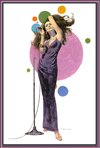
Here is a funny song performed in her inimitable style by legendary singer Helen Kane.
Helen Kane (1903-1966) was an American popular singer, best known for her "boop-boop-a-doop" trademark and her signature song, I wanna be loved by you. Fleischer Studios animator Grim Natwick used Kane as the model for his studio's most famous creation, Betty Boop.
She was born as Helen Schroeder, to a German father and an Irish mother. By the time she was 15 years old, Helen was onstage professionally, touring the Orpheum Circuit with the Marx Brothers.
Helen spent the early 1920s trouping in vaudeville as a singer, and kickline dancer with a theater engagement called the All Jazz Revue. She played the New York Palace for the first time in 1921. She also sang onstage with an early girl harmony singing trio - The Hamilton Sisters and Fordyce. The big break of Helen Kane's career came in 1927, when appearing in a musical called A night in Spain. Kane's first performance at the Paramount Theater in Times Square proved to be her defining moment and career's launching point. Kane was singing the popular song That's my weakness now, when she interpolated the scat lyrics "boop-boop-a-doop". The rather odd gamble paid off and, four days later, Helen Kane's name went up in lights. Overnight, the world changed for Helen. Kane's agent got her $5 500 a week in Oscar Hammerstein's 1928 show Good boy (where she first introduced the hit, I wanna be loved by you). She had excellent diction, intonation and timing, acquired during her apprenticeship in vaudeville. These were put to good use, as her songs have a strong word focus; they also capitalise on her pert, coquettish voice. She blended several styles which were fashionable at the end of the 1920s. These included scat singing and also blending singing and speech; Sprechgesang, or "speech-song" was fashionable at this time in the German Weimar Republic in both nightclubs and in serious music. Kane made 22 song recordings during the height of her fame, during 1928-1930. After 1930 and up to 1951, she made only five more, including a re-release of I wanna be loved by you. As she took on the status of a singing sensation, there were Helen Kane dolls and Helen Kane look-alike contests, appearances on radio and in nightclubs. In late 1928 and early 1929 this cult following had reached its peak. Kane's height (about 5 feet tall) and slightly plump figure attracted attention and fans. Her round face with its huge brown eyes was topped by black, curly hair; her voice was a baby squeak with a distinct Bronx accent. In 1930, Fleischer Studios animator Grim Natwick introduced a caricature of Helen Kane, with droopy dog ears and a squeaky singing voice, in the cartoon Dizzy dishes. "Betty Boop", as the character was later dubbed, soon became popular and the star of her own cartoons. In 1932, she was changed into a human from a dog, her long ears turning into hoop earrings. In 1932, Kane filed an unsuccessful suit against Paramount and Max Fleischer, charging unfair competition and wrongful appropriation in the Betty Boop cartoons. Margy Hines, Bonnie Poe, and, most notably, Betty Boop voice-over talent Mae Questel, were all summoned to testify. The judge ruled against Kane in 1934, claiming that Kane's testimony could not prove that her singing style was unique or not an imitation itself (a little-known black singer known as "Baby Esther" was cited by the defence as "booping" in song). She still appeared in a stage production called Shady lady in 1933, and made appearances at various nightclubs and theatres during the 1930s. In 1950, she dubbed a teenaged Debbie Reynolds who performed I wanna be loved by you in the MGM musical biopic of songwriting duo Bert Kalmar and Harry Ruby: Three little words. She did not appear in the film's credits. She appeared in several TV shows in the 1950s and 1960s, principally Toast of the Town (later episodes known as The Ed Sullivan Show). Kane's final public appearance was on the Sullivan show on St. Patrick's Day 1965.
Enjoy Helen Kane's incredible style!
I've got it



Aucun commentaire:
Enregistrer un commentaire